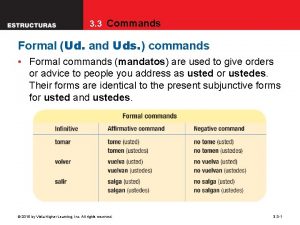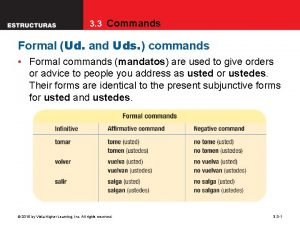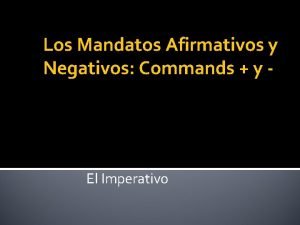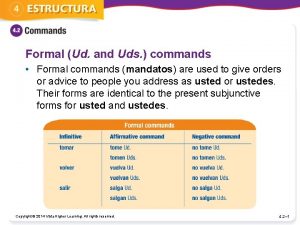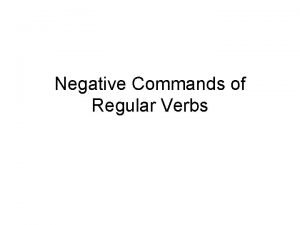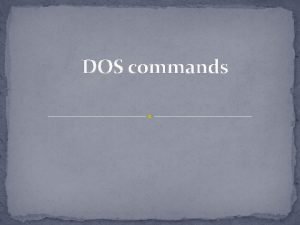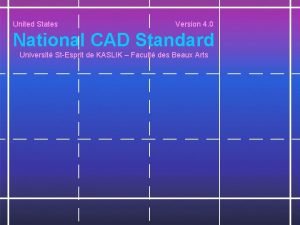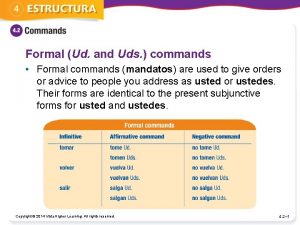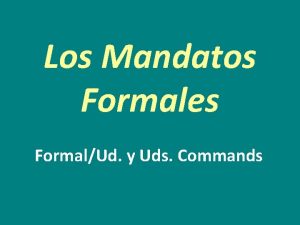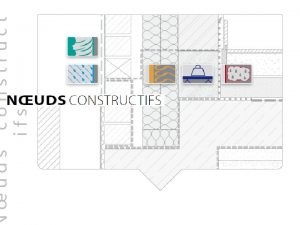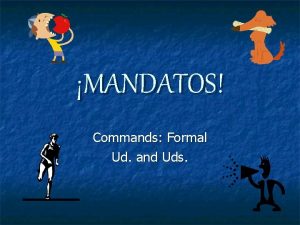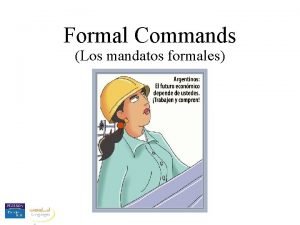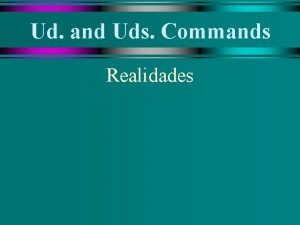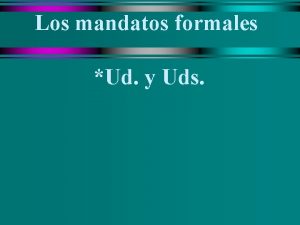Formal Ud and Uds commands Formal commands mandatos








![Indirect (él, ella, ellos, ellas) commands • The construction que + [subjunctive] in the Indirect (él, ella, ellos, ellas) commands • The construction que + [subjunctive] in the](https://slidetodoc.com/presentation_image_h2/ae38be3b1e141bb9ae18b68290bc9185/image-9.jpg)



- Slides: 12

Formal (Ud. and Uds. ) commands • Formal commands (mandatos) are used to give orders or advice to people you address as usted or ustedes. • Their forms are identical to the present subjunctive forms for usted and ustedes. © by Vista Higher Learning, Inc. All rights reserved. 4. 2– 1

Familiar (tú) commands • Familiar commands are used with people you address as tú. Affirmative tú commands have the same form as the él, ella, and usted form of the present indicative. • Negative tú commands have the same form as the tú form of the present subjunctive. © by Vista Higher Learning, Inc. All rights reserved. 4. 2– 2

• These verbs and their derivatives (predecir, deshacer, entretener, etc. ) have irregular affirmative tú commands. • Their negative forms are still the same as the tú form of the present subjunctive. • Silly Sentence said with German accent: • Vin Diesel has 10 weapons. 4. 2– 3

Vosotros/as commands In Latin America, ustedes commands serve as the plural of familiar (tú) commands. The familiar plural vosotros/as command is used in Spain. The affirmative command is formed by changing the –r of the infinitive to –d. The negative command is identical to the vosotros/as form of the present subjunctive. bailar: bailad/no bailéis For reflexive verbs, affirmative commands are formed by dropping the –r and adding the reflexive pronoun –os. In negative commands, the pronoun precedes the verb. levantarse: levantaos/no os levantéis The verb irse is irregular: idos/no os vayáis © by Vista Higher Learning, Inc. All rights reserved. 4. 2– 4

Nosotros/as commands • Nosotros/as commands are used to give orders or suggestions that include yourself as well as other people. In Spanish, nosotros/as commands correspond to the English let’s + verb! Affirmative and negative nosotros/as commands are generally identical to the nosotros/as forms of the present subjunctive. • The nosotros/as affirmative commands for ir and irse are irregular: vamos and vámonos. • The negative commands are regular: no vayamos and no nos vayamos. 4. 2– 5

Using pronouns with commands • When object and reflexive pronouns are used with affirmative commands, they are always attached to the verb. • When used with negative commands, the pronouns appear between no and the verb. (BEFORE) Levántense temprano. Wake up early. No se levanten temprano. Dime todo. Tell me everything. No me digas. Don’t tell me. © by Vista Higher Learning, Inc. All rights reserved. Don’t wake up early. 4. 2– 6

• When the pronouns nos or se are attached to an affirmative nosotros/as command, the final s of the command form is dropped. Sentémonos aquí. No nos sentemos aquí. Let’s sit here. Let’s not sit here. Démoselo mañana. No se lo demos mañana. Let’s give it to him/her tomorrow. Let’s not give it to him/her tomorrow. © by Vista Higher Learning, Inc. All rights reserved. 4. 2– 7

When one or more pronouns are attached to an affirmative command, an accent mark may be necessary to maintain the original stress. This usually happens when the combined verb form has three or more syllables. decir di, dile, dímelo diga, dígale, dígaselo digamos, digámosle, digámoselo © by Vista Higher Learning, Inc. All rights reserved. 4. 2– 8
![Indirect él ella ellos ellas commands The construction que subjunctive in the Indirect (él, ella, ellos, ellas) commands • The construction que + [subjunctive] in the](https://slidetodoc.com/presentation_image_h2/ae38be3b1e141bb9ae18b68290bc9185/image-9.jpg)
Indirect (él, ella, ellos, ellas) commands • The construction que + [subjunctive] in the third- person form to express indirect commands that correspond to the English let someone do something. If the subject of the indirect command is expressed, it usually follows the verb. Que pase el siguiente. Que lo haga ella. Let the next person pass. Let her do it. © by Vista Higher Learning, Inc. All rights reserved. 4. 2– 9

• As with other uses of the subjunctive, pronouns are never attached to the conjugated verb, regardless of whether the indirect command is affirmative or negative. Que se lo den los otros. Que no se lo den. Que lo vuelvan a hacer. Que no lo vuelvan a hacer. © by Vista Higher Learning, Inc. All rights reserved. 4. 2– 10

Turn into commands 1. Te conviene descansar. Descansa. 2. Deben relajarse. 3. Es hora de que usted tome su pastilla. 4. ¿Podría usted describir sus síntomas? 5. ¿Y si mejoramos nuestra alimentación? 6. ¿Podrías consultar con un especialista? 7. Ustedes necesitan comer bien. 8. Le pido que se vaya de mi consultorio. 3. 1 -11

____ tu medicina, por favor, para que te cures pronto. Ustedes tienen tos. _____ de fumar inmediatamente. No _______ en exceso, o Ud. va a engordar más. ¿Te duele una muela? ____ al dentista. Si tus hijos comen muchos dulces, ____ que no lo hagan tan a menudo. Por favor, que ____ el próximo paciente al consultorio. © by Vista Higher Learning, Inc. All rights reserved. 3. 1 -12
